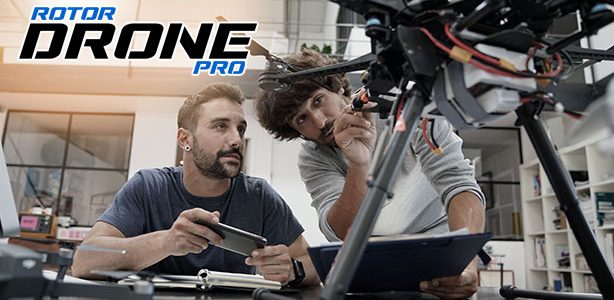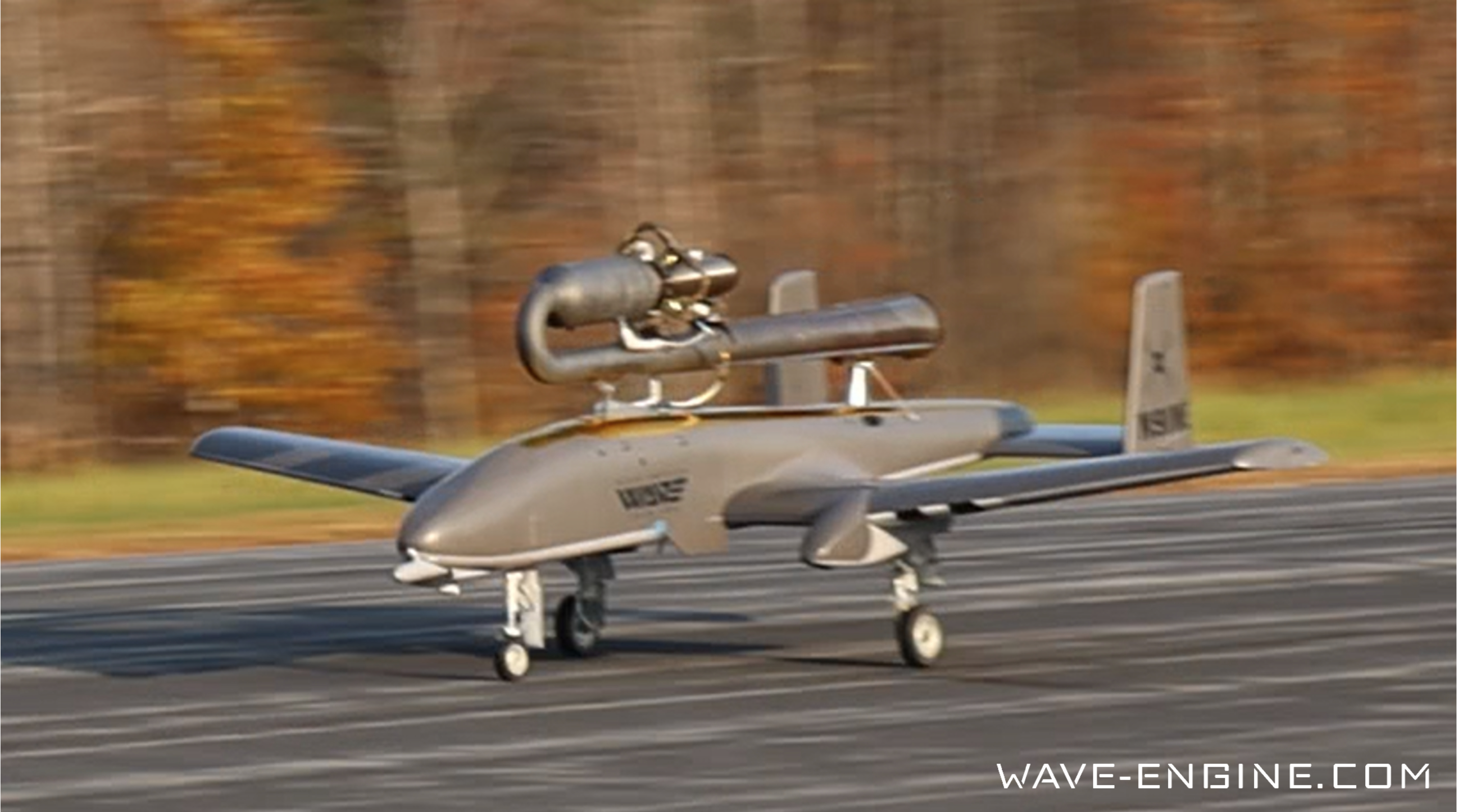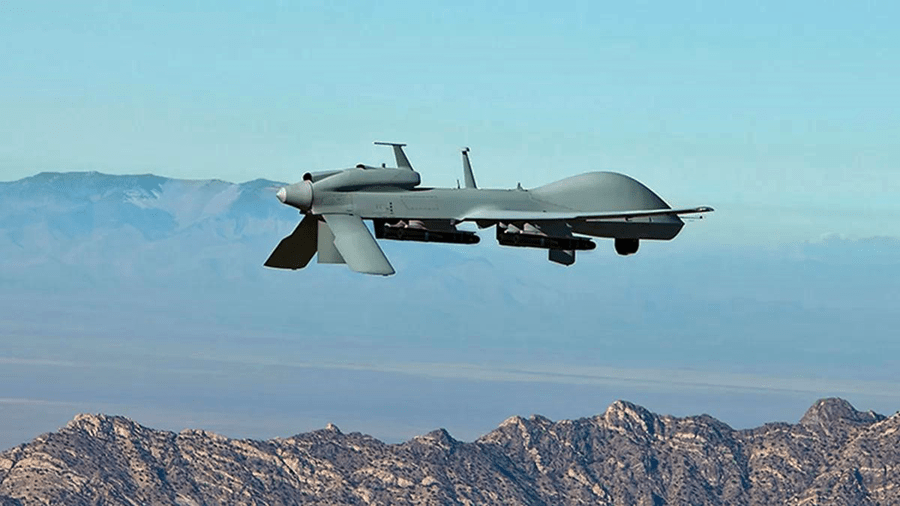-

2 Gas Engines + 4 Electric Motors = 2 Hours and 25 KG Payload
In this episode, the Roswell Flight Test Crew speaks with Eli Sayag, Vice President for Research and Development and Chief Technical Officer at CopterPIX, about the company’s new multirotor UAS: the Rhino. Described as the world’s first “Hybrid Parallel” drone, the Rhino achieves unheard of performance – being capable of flying for two hours with a 25 kilogram payload – with a unique propulsion system. The Rhino incorporates two gasoline engines which provide virtually all of the lift and thrust to support and maneuver the aircraft, while four battery-powered electric motors provide stability and allow the aircraft to maneuver. The company plans to scale up the platform to be able to transport a 100 kilogram payload. -

The Flying Propeller: A Two-Hour Drone for First Responders
In this episode, the Roswell Flight Test Crew speaks with Dennis Krause, the Chief Operating Officer and Co-Founder of Angel Aerial Systems. His company was at Commercial UAV Expo in September 2024 to promote the company’s fascinating new platform: the Trio. Developed specifically with public safety users in mind, the Trio takes off and lands like a tricopter but then, once airborne, turns into a “flying propeller.” The limbs supporting its three motors function as airfoils, allowing it to fly for two hours with an on-board battery capacity that would keep a conventional multirotor flying for 30 minutes. The Trio can fly for two hours, making it an ideal observation platform for first responders operating in tactical environments, such as firefighters and law enforcement. -

SunnySky ZMO: An Affordable VTOL Platform
In this episode, the Roswell Flight Test Crew speaks with Eddie Torres, the sales manager for SunnySky USA. The company is introducing a line of low-cost Vertical Take-Off and Landing (VTOL) aircraft, accessible to hobbyists and small commercial users. The ZMO Pro is a tri-copter design which can stay aloft for up to 45 minutes while carrying an action sports camera or DJI Air video system, to allow for a First-Person View (FPV) flying experience. The flight control system is compatible with Mission Planner, allowing it to perform autonomous, waypoint-driven missions. -

U.S. Drone Soccer: Have a Ball (or Five)!
In this episode, the Roswell Flight Test Crew speaks with Lina Pineros, the director of operations for U.S. Drone Soccer. The sport, which originated in South Korea, helps high school and college students develop technical and flight skills through an e-sports competition. Each team consists of five pilots assigned a specific role, such as the striker – the only participant able to score goals – as well as a forward, sweepers and defense. Individual rounds last for three frenetic minutes, with a brief break to swap batteries and effect repairs to damaged aircraft before resuming play. Three rounds constitutes a match, with the winner determined by cumulative score. -

Simple and Rugged Military VTOL Drone: ideaForge Switch
Hey, Crew!
Obviously, this video has been significantly delayed in its release. You have my apology for that, but I have been busy with several other projects – some of which must remain shrouded in mystery for the moment. However, here is one of them: https://a.co/d/aQnTS13, a coloring book for children entitled “DRONES: HOW THEY FLY” featuring Raven and Little Bird. Check it out! Now, on with the show!
In this episode, the Roswell Flight Test Crew speaks with Ankit Mehta, the CEO of ideaForge technology. The company has developed a multirotor-embed vertical take-off and landing (VTOL) drone for military applications – specifically in the country’s home nation of India. Lightweight and rugged, the aircraft is made of resilient foam to make sure it can withstand the rigors of real-world deployments. It carries a sensor ball equipped with visible light and thermal imaging cameras designed for maximum stand-off, ensuring that its military users are able to observe potential hostiles without being detected. -

BYOB: Bring-Your-Own-Box Drone Delivery
Hey, Crew!
Obviously, this video has been significantly delayed in its release. You have my apology for that, but I have been busy with several other projects – some of which must remain shrouded in mystery for the moment. However, here is one of them: https://a.co/d/aQnTS13, a coloring book for children entitled “DRONES: HOW THEY FLY” featuring Raven and Little Bird. Check it out! Now, on with the show!
In this episode, the Roswell Flight Test Crew speaks with Aaron Zhang, the CEO of A2Z Drone Delivery. The company manufactures a system that can be connected to any multirotor drone with sufficient carrying capacity, converting it into a delivery platform that can drop off up to a 22-pound package with a tether that detaches automatically when it makes contact with the ground. The company sees its primary market, at least initially, in the fields of industrial logistics: moving high-value cargo across relatively short distances, such as at a factory or port. -

Zephyr: Pro Training Simulator for Drones
Hey, Crew!
Obviously, this video has been significantly delayed in its release. You have my apology for that, but I have been busy with several other projects – some of which must remain shrouded in mystery for the moment. However, here is one of them: https://a.co/d/aQnTS13, a coloring book for children entitled “DRONES: HOW THEY FLY” featuring Raven and Little Bird. Check it out! Now, on with the show!
In this episode, the Roswell Flight Test Crew speaks with Kyle Bishop, the CEO of Zephyr Drone Simulator about his company’s product: a simulator built for large-scale and enterprise drone training. It incorporates a learning management system (LMS) that records all flights activities. The software covers the fundamentals, such as basic maneuvers to complex scenarios such as public safety and inspection operations, as well as the open test lane developed by the National Institute of Standards and Training (NIST) and employed in applications like the Basis Proficiency Evaluation for Remote Pilots (BPERP). It also includes a range of different aircraft from several major manufacturers. -

Flyability Elios 3: The Ultimate Indoor Drone
Hey, Crew!
Obviously, this video has been significantly delayed in its release. You have my apology for that, but I have been busy with several other projects – some of which must remain shrouded in mystery for the moment. However, here is one of them: https://a.co/d/aQnTS13, a coloring book for children entitled “DRONES: HOW THEY FLY” featuring Raven and Little Bird. Check it out! Now, on with the show!
In this episode, the Roswell Flight Test Crew speak with Zacc Dukowitz, senior communications manager at Flyability about the company’s Elios 3 confined-space inspection drone. Unlike virtually every other commercial drone in service today, the Elios 3 does not incorporate either a GPS receiver or a compass, but navigates in GPS denied environments using Simultaneously Localization and Mapping (SLAM) technology. In addition to visible light and thermal cameras, the Elios 3 incorporates a LiDAR sensor, enabling it to create precise maps of tunnels, caves, utility vaults and other dangerous, confined-space environments. -

Full-Sized Helicopter Converted to Delivery Drone
Hey, Crew!
Obviously, this video has been significantly delayed in its release. You have my apology for that, but I have been busy with several other projects – some of which must remain shrouded in mystery for the moment. However, here is one of them: https://a.co/d/aQnTS13, a coloring book for children entitled “DRONES: HOW THEY FLY” featuring Raven and Little Bird. Check it out! Now, on with the show!
In this episode, the Roswell Flight Test Crew speaks with Armen Kueleyan, sales and marketing director for Drone Delivery Canada. He discusses the Condor delivery drone, which has been adapted from a full-sized, crewed helicopter. It is capable of carrying 400 pounds at 75 MPH for 125 miles using a two-stroke, gasoline powered engine. The initial use case is the delivery of supplies to remote natural resource extraction sites across the northern reaches of Canada. The aircraft is controlled from a command center using the company’s FLYTE software package. -

This eBee can sting!
Hey, Crew!
Obviously, this video has been significantly delayed in its release. You have my apology for that, but I have been busy with several other projects – some of which must remain shrouded in mystery for the moment. However, here is one of them: https://a.co/d/aQnTS13, a coloring book for children entitled “DRONES: HOW THEY FLY” featuring Raven and Little Bird. Check it out! Now, on with the show!
In this episode, the Roswell Flight Test Crew speaks with Gary Licquia, regional manager for AgEagle Aerial Systems about the eBee TAC: a foam airplane – believe it or not – developed specifically for military and special forces applications. Unlike most military UAS, it has not been developed for real-time surveillance and reconnaissance, but rather to conduct orthomosaic mapping, much like the civilian version of the eBee. The value to military users is that these maps can be constructed quickly, in the field, and do not constitute classified data – so they can be readily shared even across open networks, to ensure warfighters get the information they need without security risks. -

FLIR SIRAS Drone: Rugged and Secure for Public Safety Users
Hey, Crew!
Obviously, this video has been significantly delayed in its release. You have my apology for that, but I have been busy with several other projects – some of which must remain shrouded in mystery for the moment. However, here is one of them: https://a.co/d/aQnTS13, a coloring book for children entitled “DRONES: HOW THEY FLY” featuring Raven and Little Bird. Check it out! Now, on with the show!
In this episode, the Roswell Flight Test Crew speaks with Kelly Brodbeck, UAS Product Manager at Teledyne-FLIR about the company’s first in-house drone: SIRAS, developed for firefighters and other public safety officials who need a rugged and secure aerial imaging solution. The aircraft has an IP54 rating, no geofencing and zero Internet connectivity required to fly or even to update its firmware. This feature has been developed to ensure that the user’s data remains private and secure. Capable of flying for 31 minutes, it incorporates both visible light and thermal cameras on an interchangeable payload as well as radar for collision avoidance. -

DroneTech UAV: Delivers at Sea
At the 2022 AUVSI Xponential Show in Orlando, Florida, DroneTech UAV introduced its AV2 Pelican delivery drone, which has been optimize for the maritime environment. With two separate gasoline motors, which can also be powered by heavy fuel, the AV2 Pelican is available in two configurations. The first incorporates an embedded multirotor for vertical take-off and landing (VTOL) capability, while the other flies exclusively as a fixed-wing platform. With multiple redundant systems, the AV2 can deliver a 10 pound payload to a ship sailing at speeds up to 30 knots.
Roswell Flight Test Crew



















